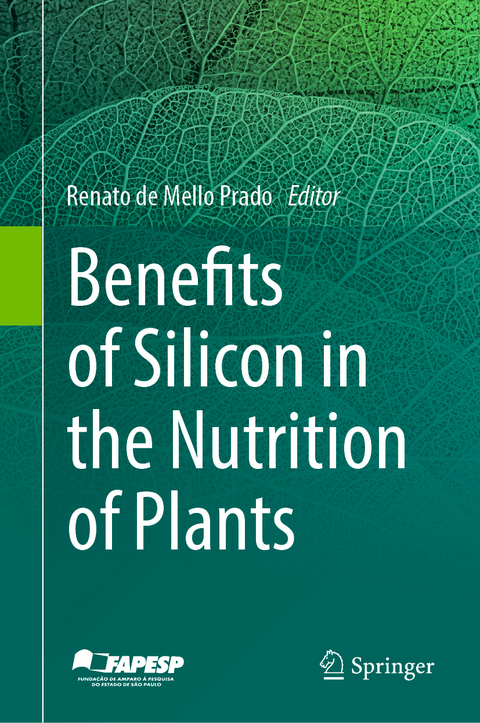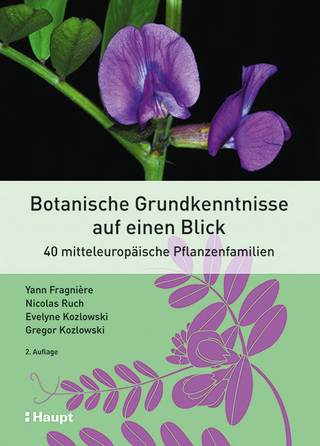
Benefits of Silicon in the Nutrition of Plants
Springer International Publishing (Verlag)
978-3-031-26672-0 (ISBN)
Renato de Mello Prado has a PhD in Agronomy from the São Paulo State University (Unesp) Campus of Jaboticabal, Brazil and did postdocs at the University of Cordoba and the Public University of Navarra, Spain. He is a professor of Plant Nutrition at Unesp since 2003 and coordinates a research group (Genplant) focused on the nutrition of tropical plants. He has published over 500 articles in peer-review journals and 30 academic books.
Contents.- 1-Silicon biogeochemistry in terrestrial ecosystems.- Jörg Schaller, Daniel Puppe.- 1.1 Introduction.- 1.2 Silicon chemistry in soils.- 1.3 Silicon cycling in natural and agricultural plant-soil systems.- 1.3.1. Si bioavailability.- 1.3.2. Si cycling in natural plant-soil systems.- 1.3.3 Si cycling in agricultural plant-soil systems.- 1.4 Silicon mitigating drought.- 1.5 Si controlling nutrient availability and carbon turnover.- 1.6 Concluding remarks.- Reference.- 2- Silicon: transcellular and apoplastic absorption and transport in the xylem .- Rafael Ferreira Barreto, Lúcia Barão.- 2.1 Introduction.- 2.2 Active uptake of Si.- 2.3 Passive uptake of Si.- 2.4 Rejection uptake of Si.- 2.5 Si transport in the xylem.- Reference.- 3- Root silicification and plant resistance to stress .- Zuzana Lukacova, Boris Bokor, Marek Vaculík, Jana Kohanová, Alexander Lux.- Introduction .- Sites of Sideposition in roots.- Silicon transport in plants - from chemistry to cell biology and anatomy.- Silicification in the root cell walls.- Cellulose and Polysaccharides.- Lignin.- Callose.- Proteins.- Phytoliths.- Stegmata.- The function of silica deposits in roots .- Reference.- 4- Dynamics of silicon in soil and plant to establish silicate fertilization.- Brenda S Tubana.- 4.1 Introduction.- 4.2 Silicon in soils.- 4.3 Components of silicon cycle in soil.- 4.4 Bases of silicon fertilization.- 4.5 Conclusion.- 4.6 Reference.- 5- Innovative sources and ways of applying silicon to plants.- Rilner Alves Flores, Maxuel Fellipe Nunes Xavier.- 5.1 Introduction.- 5.2 Sources and ways of supplying Si to tropical crops.- 5.2.1 Silicon sources for soil application or fertigation in tropical regions .- 5.2.2 Silicon sources for foliar application in tropical regions.- 5.3 Final considerations.- Reference.- 6- Silicon mitigates the effects of nitrogen deficiency in plants.- Cid Naudi Silva Campos, Bianca Cavalcante da Silva 6.1 Introduction.- 6.2 Biochemical and physiological effects of N deficiency in plants.- 6.3 Beneficial effect of Si on plants under nutrient deficiency stress.- 6.4 Beneficial action of Si in tropical plants under N deficiency: how can Si mitigate the effects of N deficiency?.- 6.5 Concluding remarks.- Reference.- 7-Silicon mitigates the effects of phosphorus and potassium deficiency in plants .- Gustavo Caione.- 7.1 Introduction.- 7.2 Silicon in the plant.- 7.3 The role of silicon in potassium-deficient plants.- 7.4 The role of silicon in phosphorus-deficient plants.- Reference.- 8- Silicon mitigates the effects of calcium, magnesium and sulfur in plants.- Dalila Lopes da Silva, Renato de Mello Prado 8.1 The relationship calcium and silicon.- 8.1.1 General aspects.- 8.1.2 Sources of calcium and silicon.- 8.1.3 Physiological and biochemical benefits of silicon in mitigating nutritional calcium deficiency.- 8.2 The relationship between magnesium and silicon.- 8.3 The relationship between sulfur and silicon.- 8.4 Conclusions and future perspectives.- Reference.- 9- Silicon mitigates the effects of zinc and manganese deficiency in plants.- Kamilla Silva Oliveira, Guilherme Felisberto, Renato de Mello Prado.- 9.1 Zinc deficiency in tropical plants.- 9.2 Silicon mitigates the effects of zinc deficiency in tropical plants.- 9.2.1 Silicon influences zinc uptake and accumulation.- 9.2.2 Silicon acts on oxidative metabolism and reduces zinc deficiency symptoms.- 9.2.3 Silicon improves physiological responses and increases production in Zn-deficient plants.- 9.3 Manganese deficiency in tropical plants.- 9.4 Silicon mitigates the effects of manganese deficiency in tropical plants.- 9.4.1 Silicon influences manganese uptake and accumulation.- 9.4.2 Silicon acts on oxidative metabolism and reduces manganese deficiency symptoms.- Reference.- 10-Silicon mitigates the effects of boron deficiency and toxicity in plants .- Davie Kadyampakeni, Jonas Pereira de Souza Júnior.- 10.1 Introduction.- 10.2 Boron and silicon interaction in the development of tropical crops.- 10.2.1 Effect on soil solution and root system development.- 10.2.2 Effect on shoot growth and biomass production.- 10.2.3 Effect on the development of reproductive organs.- 10.3 Final considerations.- Reference.- 11- Silicon mitigates the effects of iron deficiency.- Luis Felipe Lata-Tenesaca, Diego Ricardo Villaseñor Ortiz.- 11.1 Introduction .- 11.2 Iron uptake and the benefits of Si.- 11.3 Iron redistribution and the benefits of Si.- 11.4 Effect of Si on oxidative stress in Fe-deficient plants.- 11.5 Final considerations and future perspectives.- Reference.- 12-Silicon mitigates the effects of aluminium toxicity .- Martin J. Hodson.- 12.1 Introduction.- 12.2 A historical perspective.- 12.3 A Brief Consideration of silicon and aluminium in Soils.- 12.4 Silicon and aluminium uptake and accumulation by plants.- 12.4.1 Silicon uptake and accumulation.- 12.4.2 Aluminium uptake and accumulation.- 12.4.3 The interaction between silicon and aluminium uptake and accumulation.- 12.5 The amelioration of aluminium toxicity by silicon in experiments carried out in hydroponic cultures.- 12.5.1 Plant growth.- 12.5.2 Effects on mineral nutrition.- 12.5.3 Effects on oxidative damage.- 12.6 Co-deposition of silicon and aluminium.- 12.6.1 Co-deposition in roots.- 12.6.2 Co-deposition in conifer needles.- 12.6.3 Co-deposition in the leaves of dicot trees.- 12.6.4 Co-deposition in other systems.- 12.7. Possible mechanisms for the mitigation effect.- 12.7.1 Solution effects.- 12.7.2 Mitigation in root systems.- 12.7.3 Mitigation in shoot systems.- 12.7.4 Mitigation in tissue culture systems.- 12.8 Mitigation in plants grown in soil.- 12.9. Conclusion.- Reference.- 13- Structural role of silicon-mediated cell wall stability for ammonium toxicity alleviation.- Mikel Rivero-Marcos, Gabriel Barbosa Silva Júnior, Idoia Ariz 13.1 Introduction.- 13.2 Metabolic targets and structural vulnerability in root cell membranes and cell walls in response to ammonium toxicity.- 13.2.1 High ammonium uptake increases AMT-dependent apoplastic acidification.- 13.2.2 Translocation of ammonium from the root increases ammonium assimilation and acidification in the shoot.- 13.2.3 Ammonium nutrition decreases protein N-glycosylation-dependent ammonium efflux and arrests root elongation.- 13.2.4 Internal ammonium accumulation initiates ROS-dependent cell wall lignification and limits cell growth.- 13.3 Repairing role of Si in plant cell structural components resulting from ammonium nutrition. .- 13.3.1 Silicon decreases oxidative stress caused by excess ammonium .- 13.3.2 Structural role of Si in cell wall stability aiming at ammonium toxicity alleviation.- 13.3.3 Silicon supply mitigates ammonium toxicity symptoms related to plant growth and development.- 13.4 Conclusions and future perspective.- Reference.- 14- Silicon mitigates the effects of potentially toxic metals.- Lilian Aparecida de Oliveira, Flávio José Rodrigues Cruz, Dalila Lopes da Silva, Cassio Hamilton Abreu Junior, Renato de Mello Prado 14.1 Introduction.- 14.2 Hm stress mitigation mechanisms.- 14.3 Effects of silicon on absorption, transport and accumulation of Hm.- 14.4 Antioxidant defense mechanisms.- 14.5 Morphological alterations.- 14.6 Altering gene expression.- 14.7 Conclusions.- Reference.- .- 15- Beneficial role of silicon in plant nutrition under salinity conditions.- Alexander Calero Hurtado; Dilier Olivera Viciedo; Renato de Mello Prado.- 15.1 Introduction.- 15.2 Silicon and salt stress remediation.- 15.3 Role of Si in decreasing Na+ uptake, transport, and accumulation.- 15.4 Increasing mineral uptake by Si under salt stress .- 15.5 Especial role of Si in increasing plant growth, biomass, and yield under salt stress.- 15.6 Conclusions.- Reference.- 16-Silicon mitigates the effects of water deficit in plants.- Gelza Carliane Marques Teixeira; Renato de Mello Prado.- 16.1 Introduction.- 16.2 Damage to tropical plants caused by water deficit .- 16.3 Plant defense system against damage caused by water deficit.- 16.4 Silicon for mitigating damage to tropical plants caused by water deficit .- 16.5 Fertigation and leaf spraying with silicon.- 16.6 Conclusion.- Reference.- 17-Association of silicon and soil microorganisms induces stress mitigation, increasing plant productivity.- Krishan K. Verma, Xiu-Peng Song, Munna Singh, Dan-Dan Tian, Vishnu D. Rajput, Tatiana Minkina, Yang-Rui Li.- 17.1 Introduction.- 17.2 Impact of Si and plant microbiome on plants.- 17.3 Role of plant rhizobacteria and Si on plants during environmental stress .- 17.4 Role of plant hormones with the application of plant microbes and silicon.- 17.5 Crop rotation and fertilizer use .- 17.6 Limitations and concluding remarks of the study.- Reference.- 18- Heat stress mitigation by silicon nutrition in plants: a comprehensive overview.- Jayabalan Shilpha, Abinaya Manivannan, Prabhakaran Soundararajan, Byoung Ryong Jeong.- 18.1 Introduction.- 18.2 Impact of heat stress on plants.- 18.3 Versatile functions of silicon in mitigating stress.- 18.4 Silicon in ROS homeostasis.- 18.5 Si-mediated regulation of heat stress tolerancein plants.- 18.5.1 Rice.- 18.5.2 Wheat.- 18.5.3 Barely.- 18.5.4 Date Palm.- 18.5.5 Tomato.- 18.5.6 Strawberry.- 18.5.7 Cucumber.- 18.5.8 Poinsettia.- 18.5.9 Salvia.- 18.6 Conclusions.- Reference.- 19-Silicon in plants mitigates damage against pathogens and insect pests.- Waqar Islam, Arfa Tauqeer, Abdul Waheed, Habib Ali, Fanjiang Zeng.- Introduction.- 19.2 Mechanisms of silicon against insect pests and pathogens .- 19.2.1 Formation of physical barrier .- 19.2.2 Biochemical mechanisms.- 19.2.3 Biochemical mechanism and physically barrier: a joint action.- 19.3 In-vivo and in-vitro application of silicon for disease and insect pest management .- 19.3.1 Role of silicon in viral disease management.- 19.3.2 Role of silicon in bacterial disease management.- 19.3.3 Role of silicon in fungal disease management.- 19.3.4 Role of silicon in insect pest management.- 19.4 Concluding remarks.- Reference.
| Erscheinungsdatum | 24.06.2023 |
|---|---|
| Zusatzinfo | X, 378 p. 73 illus., 57 illus. in color. |
| Verlagsort | Cham |
| Sprache | englisch |
| Maße | 155 x 235 mm |
| Gewicht | 746 g |
| Themenwelt | Naturwissenschaften ► Biologie ► Botanik |
| Weitere Fachgebiete ► Land- / Forstwirtschaft / Fischerei | |
| Schlagworte | biofortification with silicon • Copper Toxicity • crop sustainability • Iron Deficiency • phosphorus and potassium deficiency • phosphorus and potassium deficiency • Plant nutrition • silicon attenuates nutritional deficiency • silicon attenuates toxicity • silicon deficiency • silicon in plant nutrition • silicon in tropical plants • stresses in crops • sustainable development • transcellular and apoplastic absorption |
| ISBN-10 | 3-031-26672-2 / 3031266722 |
| ISBN-13 | 978-3-031-26672-0 / 9783031266720 |
| Zustand | Neuware |
| Informationen gemäß Produktsicherheitsverordnung (GPSR) | |
| Haben Sie eine Frage zum Produkt? |
aus dem Bereich


